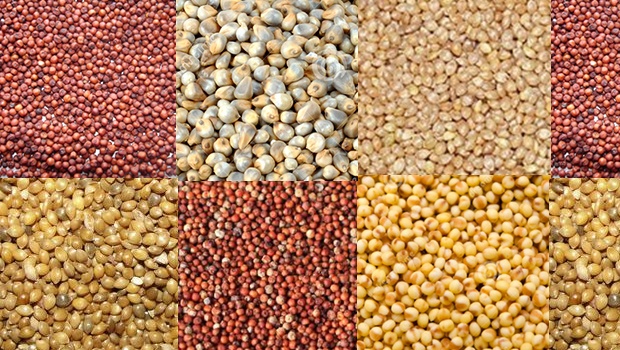
Millets are coarse grains that are traditionally grown and consumed in the Indian subcontinent for years. They have high nutritional value and are rich in proteins, vitamins, minerals, and fibres. Unlike other cereals, millets require little water and ground fertility. The sheer affordability of millets also tags them as “poor man’s food grain”. The world is now noticing millets for their enormous potential.
Millets are a powerhouse of nutrients. They have reclaimed their space in the kitchen of those more health-conscious. Millets boost your health and improve weight loss, besides being gluten-free. Speak to any fitness enthusiast, and they will vouch for the miraculous benefits of eating millet.
Millets are available in a variety of types, and each has its health benefits. Walk into a supermarket at any time of the year, and you will find millets in stock. That is because of their cultivation across seasons.
Consuming millets as part of your daily diet is an age-old concept. The population of central and southern India consumed millet daily until the Green Revolution made rice and wheat more accessible. However, government policies did not provide incentives for growing millets. On the contrary, it discouraged farmers from cultivating millets. Therefore, consumption of millets reduced as the produce quantum dipped. However, ditching rice or wheat bread entirely for millets is not healthy for your body—practice grain diversity in your diet for wholesome nutrition.
Two broad categories of Millets
Naked grains
Naked grains refer to the millets devoid of the tough, indigestible husk, namely, Ragi, Jowar, and Bajra. These millets don’t require processing after their harvest. They can be consumed right after cleaning. These millets are therefore significantly cultivated today.
Husked grains
Foxtail millets, Little millets, and Kodo millets belong to this second type. These types consist of an indigestible seed coat that has to be removed before consumption. The processing, once done by hand, is now mechanical and mainly used for rice than for millets, making them less popular.
Millets contain a host of micronutrients such as iron, calcium, and phosphorus. Also, they take time to digest, which doesn’t cause the blood sugar spike associated with easily digestible food. So introducing millets into your diet can help control diabetes for the same reason.
Therefore, millets are good for health. Millet production is good for the environment. It is because they are primarily rain-fed crops. Consequently, they do not put pressure on our already diminishing water resources. Additionally, these grain crops do not attract pests and can grow perfectly well without pesticides.
Types of Millets
Millets come in different shapes and sizes. The two broad categories discussed above contain numerous kinds of millets. We will take a look at some of these different types below:
Foxtail Millet
Foxtail millet, or indigenously called Kakum/Kangni. It contains blood sugar balancing healthy carbohydrates. The iron and calcium content present in it also helps strengthen immunity. In addition, foxtail millets help regulate your blood cholesterol and increase HDL cholesterol levels in your body.
Finger Millet/Ragi
Ragi is a more common name for finger millet. It is used as a healthier cereal substitute for rice and wheat. Ragi is gluten-free and rich in protein. Ragi is supposed to aid brain development in growing children.
Pearl Millet/Bajra
Bajra is incredibly nutrient-dense. It contains minerals such as calcium and magnesium, protein, fibre, and iron. Practice regular consumption of pearl millet to fight against type II diabetes.
Buckwheat
Go for buckwheat if your primary concern is to lose weight. It makes for a healthy food option for diabetes, helps lower blood pressure, and improves cardiovascular health. Buckwheat also fights against diseases such as gallstones, childhood asthma, and breast cancer.
Little Millet
Little millet is also an excellent option for those looking to lose weight. You can eat it as a rice replacement. It is high in fibre and filled with numerous minerals such as potassium, zinc, iron, and calcium. It is also packed with the health benefits of vitamin B and works as an antioxidant for your body.
Benefits of Millets
Millets are rich in several beneficial nutrients, such as phosphorus, magnesium, copper, and manganese. Incorporate them into your diet to gain the following benefits:
Weight Loss
The calorie content of millets is low, and they are an excellent food product for weight loss. Not just those looking to lose weight, it benefits people who are conscious of their fitness too. It helps them maintain their energy level throughout the day without having to eat to refuel themselves constantly.
Millets also keep you satiated for longer than other carbohydrates. When you consume them, you feel fuller for longer as they take time to get digested and absorbed into your body. That prevents snacking and overeating.
Maintain Blood Sugar Levels
Millets have a low glycaemic index. Therefore, consume millet regularly to lower your risk of developing diabetes.
Boost Immunity
Protein intake is responsible for building the body’s immunity. Millets provide a great source of protein and can help develop and strengthen our immunity. Stronger immunity means fewer chances of you catching diseases.
Reduces Cardiovascular Risks
Millets contain essential fats, which provide our bodies with good fats which prevent excess fat storage as well as effectively lower the risk of high cholesterol, strokes, and other heart complaints. The potassium content in millets regulates your blood pressure and optimises your circulatory system.
Prevents Asthma
The magnesium content in millets can reduce how frequently you experience migraines. It can also bring down the severity of your asthma complaints. The reason is, unlike wheat, they do not contain the allergens that lead to asthma and wheezing.
Help in Digestion
Millets are a rich fibre source that benefits digestion by alleviating bloating, gas, cramping, and constipation. In addition, good digestion keeps issues like gastric/colon cancer and kidney/liver complaints away.
Acts as an Antioxidant
Millets help your body detox because of their antioxidant properties; Quercetin, curcumin, ellagic acid, and other valuable catechins flush out toxins from your body and neutralise the enzymatic actions of your organs.
Millet Recipes
The uses of millets are diverse. You can cook them for breakfast, lunch or dinner. Use millet rice instead of white rice in your recipes, and your dishes will be significantly healthier. Given below is a rice-substitute millet preparation recipe.
Vegan Millet Sushi with Roasted Root Vegetables and Broccoli Cream
Serving Size – 5 sushi rolls
Preparation Time – 45-50 minutes
Ingredients:
For the Roasted Root Vegetables
- 1/2 tbsp oil
- ¼ tsp salt
- 100g each of carrot, turnip, root celery, and beet strips
For the Broccoli Cream
- 50 g each of peeled sunflower seeds and broccoli florets
- 180 ml cold water
- 1 tbsp soy sauce
For the millet
- 250 g uncooked millet
- 1.2 l water
- ½ tsp salt
You will also need 5 nori sheets and tamari sauce for serving.
Instructions:
1. Bake the vegetables first. Preheat the oven to 400F, and put your vegetable strips onto a covered baking tray with a sprinkle of oil. Add some salt over the vegetables and bake them in the oven for 35 minutes or lightly browned. Take the tray out of the oven and allow the baked vegetables to cool.
2. Now, mix the millet with water and salt and bring it to a boil. Boil this mixture on medium heat for about 15 minutes. Once it has softened, keep it aside and let it cool down.
3. Boil the broccoli florets and sunflower seeds in water for 15 minutes and then drain and rinse these boiled vegetables with cold water. Add this cooked broccoli and sunflower seeds to a blender with cold water, soy sauce, and vinegar. Blend for a handful of minutes until you obtain a smooth mixture and set it aside.
4. Take a rolling mat and your nori sheets and prepare to make your sushi. First, add about a tablespoon of millet and spread it out. Then add some roasted veggies and a little of that broccoli cream.
5. Moisten the top of the nori sheet with some water and roll it into a tight sushi roll. Repeat the same process five times and then use a sharp wet knife to cut the sushi into pieces. Serve this sushi with leftover broccoli cream and tamari sauce. Enjoy your millet rice sushi.
Summary
Millets flew under the radar with the presence of more popular cereals, like rice and wheat. It was only recently that health and fitness enthusiasts from across the world understood its potential. The health benefits that the humble food grain offers are truly unique.
Unlike wheat and rice, millet cultivation is incredibly sustainable. This food grain benefits our bodies by strengthening our immunity, keeping diseases in check, and aiding weight loss. In addition, millets take longer to break down in the body and keep us satiated for longer.
There are many ways to include millets in your diet. You can use this food grain as a cereal substitute, make porridge, or infuse it into cupcakes – the uses of millets in cuisine are endless. So include this superfood in your everyday diet and notice the positive changes it brings to your life.
Financial and Business expert having 30+ Years of vast experience in running successful businesses and managing finance.





